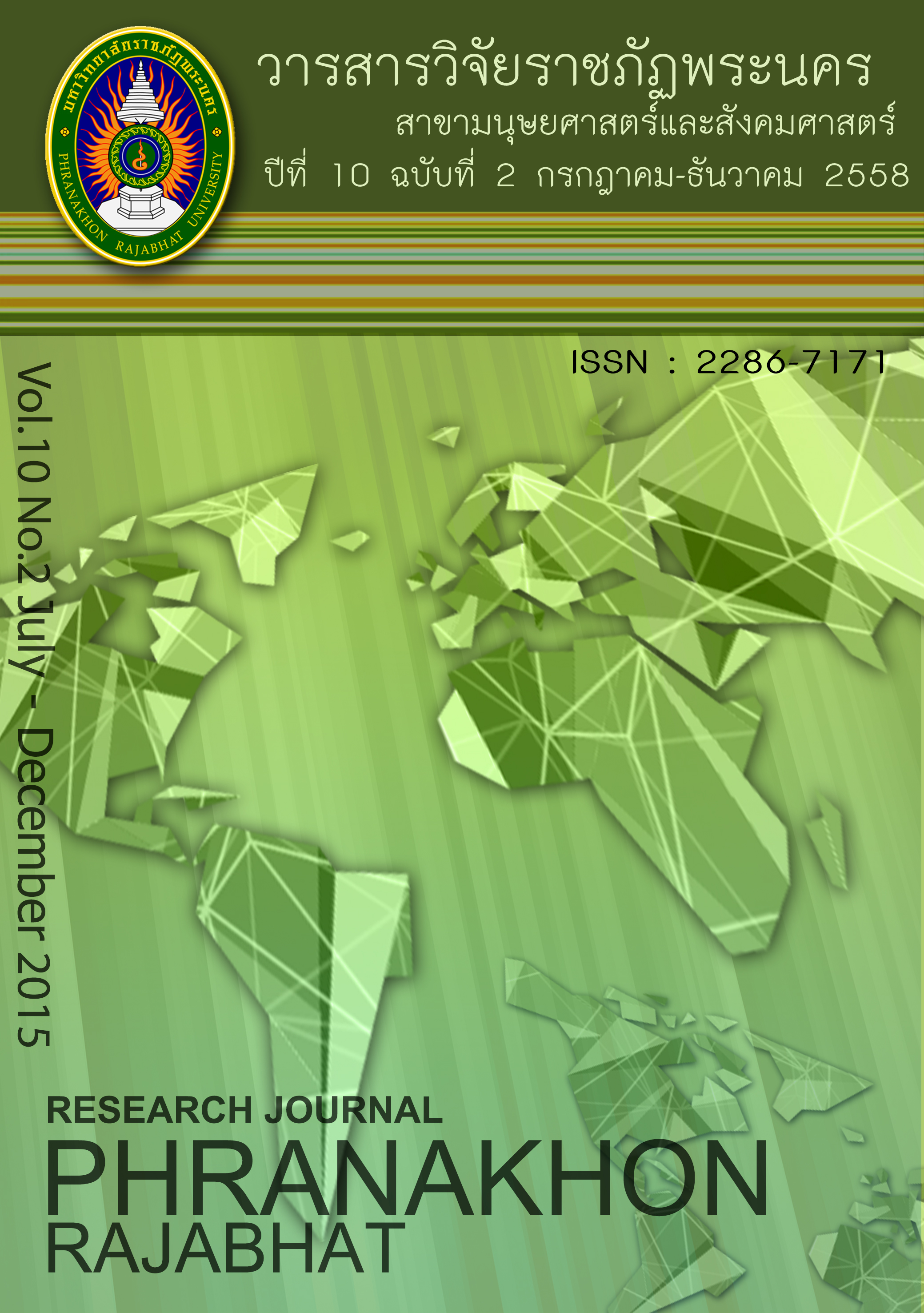การพัฒนาคุณภาพชีวิตผู้สูงอายุที่เป็นโรคเบาหวานในตำบลท่าดินดำ อำเภอชัยบาดาล จังหวัดลพบุรี
Main Article Content
Abstract
การวิจัยในครั้งนี้มีวัตถุประสงค์ของการวิจัยคือ 1) เพื่อศึกษาบริบทและความต้องการของประชาชนตำบลท่าดินดำ อำเภอชัยบาดาล จังหวัดลพบุรี 2) เพื่อศึกษาความสามารถในการดูแลตนเองของผู้สูงอายุที่เป็นโรคเบาหวาน 3) เพื่อออกแบบและทดลองใช้กิจกรรมพัฒนาคุณภาพชีวิตของผู้สูงอายุที่เป็นโรคเบาหวาน และ 4) เพื่อประเมินการพัฒนาคุณภาพชีวิตของผู้สูงอายุที่เป็นโรคเบาหวาน ประชากรเป็นผู้สูงอายุในตำบลท่าดินดำ อำเภอชัยบาดาล จังหวัดลพบุรี จำนวน 759 คน กลุ่มตัวอย่างเป็นผู้สูงอายุที่สมัครใจเข้าร่วมโครงการวิจัย จำนวน 33 คน เครื่องมือในการวิจัยประกอบด้วย 1) แบบสัมภาษณ์ 2) แบบบันทึกพฤติกรรมการพัฒนาคุณภาพชีวิต และ 3) แบบสอบถามความสามารถในการดูแลตนเองของผู้ป่วยเบาหวานและอุปกรณ์การเก็บข้อมูล ได้แก่ เครื่องมือวัดความดันเลือด เครื่องเจาะและวัดระดับน้ำตาลในเลือดผลการวิจัยพบว่า 1) ด้านบริบทพบว่าตำบลท่าดินดำ อำเภอชัยบาดาล จังหวัดลพบุรี มีประชากรทั้งสิ้น 4,516 คน เป็นผู้สูงอายุ 759 คน คิดเป็นร้อยละ 16.81 ในจำนวนนี้เป็นโรคเบาหวาน 171 คน คิดเป็นร้อยละ 22.53 โดยจำแนกเป็นระดับ สีเขียวเข้ม (<125 mg/dl) จำนวน 10 คน คิดเป็นร้อยละ 30.30 สีเหลือง (125-154 mg/dl) จำนวน 8 คน คิดเป็นร้อยละ 24.24 สีส้ม (155-182 mg/dl) จำนวน 6 คน คิดเป็นร้อยละ 18.18 และสีแดง (≥183 mg/dl) จำนวน 9 คน คิดเป็นร้อยละ 27.28 2) ความสามารถในการดูแลตนเองของผู้สูงอายุที่เป็นโรคเบาหวาน 5 ด้าน คือ 2.1) ด้านการควบคุมอาหาร ที่ปฏิบัติเป็นประจำ คือ การรับประทานอาหารวันละ 3 มื้อ รับประทานอาหารตรงเวลา และการควบคุมน้ำหนักตนเองอย่างสม่ำเสมอ ส่วนที่ไม่เคยปฏิบัติ คือ การไม่รับประทานขนมหรือของทอดระหว่างมื้ออาหาร 2.2) ด้านการออกกำลังกาย ที่ปฏิบัติเป็นประจำ คือ เลือกกิจกรรมการออกกำลังกายเหมาะสมกับวัยและภาวะสุขภาพ ส่วนที่ไม่เคยปฏิบัติ คือ การอบอุ่นร่างกายและผ่อนคลายกล้ามเนื้อทุกครั้งก่อนออกกำลังกาย 2.3) ด้านการรับประทานยาและการติดตามการรักษา ที่ปฏิบัติเป็นประจำ คือ การมาตรวจตามนัด ได้งดน้ำ งดอาหารหลังเที่ยงคืนก่อนมาตรวจทุกครั้ง 2.4) ด้านการดูแลสุขภาพอนามัยการดูแลเท้าที่ปฏิบัติเป็นประจำ คือ อาบน้ำทำความสะอาดร่างกายด้วยน้ำและสบู่วันละ 1-2 ครั้ง ซับให้แห้งตามซอกอับข้อพับต่าง ๆ ส่วนที่ไม่เคยปฏิบัติคือ เมื่อปลายเท้าเปลี่ยนเป็นสีม่วงคล้ำท่านจะไปพบแพทย์ทันที 2.5) ด้านการป้องกันและแก้ไขภาวะแทรกซ้อนที่ปฏิบัติเป็นประจำ คือ ควบคุมความดันโลหิตให้อยู่ในช่วง 130/85 มม.ปรอท โดยการออกกำลังกาย ควบคุมอาหารหรือรับประทานยาลดความดันโลหิต ส่วนที่ไม่เคยปฏิบัติคือ เมื่อเกิดบาดแผลผู้สูงอายุที่เป็นโรคเบาหวานจะทำความสะอาดบาดแผลและใช้เบตาดีนทาบริเวณแผล 3) การออกแบบกิจกรรมพัฒนาคุณภาพชีวิต ประกอบด้วยภาคทฤษฎี เป็นการให้ความรู้เกี่ยวกับโรคเบาหวาน ภาคปฏิบัติมี 4 ฐาน ได้แก่ ฐานที่ 1 การรับประทานอาหาร ฐานที่ 2 การจัดการอารมณ์ ฐานที่ 3 หลักการใช้ยา และฐานที่ 4 การออกกำลังกาย 4) ผลการประเมนิ การจัดกิจกรรมพัฒนาคุณภาพชีวิต หลังจากผู้สูงอายุที่เป็นโรคเบาหวานปฏิบัติตามกิจกรรมเป็นเวลาสามเดือน พบว่าจำนวนผู้ที่มีระดับน้ำตาลในเลือดต่ำ (ต่ำกว่า 125 mg/dl และ 125-154 mg/dl) มีแนวโน้มเพิ่มขึ้นจากการตรวจครั้งแรก ส่วนจำนวนผู้ที่มีระดับน้ำตาลในเลือดสูง (155-182 mg/dl และมากกว่า 182 mg/dl) มีแนวโน้มลดลงเป็นที่น่าพอใจ
The purposes of this research were (1) to study the context and needs of people in hadindum Subdistrict, Chai Badan District, Lopburi Province, (2) to study self-care ability of the elderly with diabetes, (3) to design activities for improving quality of life of the elderly with diabetes, and (4) to evaluate the life quality development of the elderly with diabetes. Populations were 759 elderly who were lived in Thadindam Sub-district, Chai Badan District, Lopburi Province. The samples were 33 volunteer elderly with diabetes. The instruments were 1) the interview form, 2) the behavior recording form, and 3) the questionnaire for measuring the self-care ability. The instruments included the Automatic Blood Pressure Monitor and also the Onetouch Select Glucose Meter.
The research findings were as follows: 1) By contexts, Thadindam Sub-district, Chai Badan District, Lopburi Province had 4,516 total population, 759 were elderly (16.81%) and 171 (22.53%) of them were diabetes. By level of blood glucose, they were classified into 4 color groups: the dark green group (<125 mg/dl) had 10(30.30%), the yellow group (125-154 mg/dl) had 8 (24.24%), the orange group (155-182 mg/dl) had 6 (18.18%) and the red group (≥ 183 mg/dl) had 9 (27.28%). 2) The result of study self-care ability: (1) In the aspect of daily food control, they regularly had 3 meals per day, on time and controlled body weight. However, they did not abstain from consuming sweets or deep fried foods. (2) In the aspect of exercise, they regularly choose activities that suited for their age and health conditions. However, they did not warm-up or did not do progressive muscle relaxation before exercise. (3) In the aspect of medication and follow up the results of medical examination, they have health checking on time date, did not drink water or eat any foods after midnight before medical examination. (4) In the aspect of hygiene and foot care, they regularly take a bath and clean with soaps 1-2 times a day, and dry their bodies in the areas of joints. They did not get along with the suddenly go to see doctors when their tiptoes turned dark purple. (5) In the aspect of regular rotecting and alleviating diabetes complications, they can control their blood pressure at 130/85 mm./mercury by exercising, controlling intake and taking medicine. They did not get long with cleaning wounds with Betadine. 3) The activities for improving life quality consists of 2 parts. Firstly, the theoretical part is an explanation about diabetes. Secondly, the practical part, consisted of 4 activities stations: (1) food, (2) emotion, (3) medication, and (4) exercises. 4) the results shown that after three months practice with those activities, the numbers of the elderly with diabetes who had sugar level below 125 mg/dl and 125-154 mg/dl had tendency to increase more than the first examination. For those who had sugar level at 155-182 mg/dl or higher than 182 mg/dl, the numbers had tendency to lower
Article Details
Each publish articles were copyright by Phranakorn Rajabhat University
Any contents which appeared in each articles in the journal were authors personal opinion. It did not relate to Phranakorn Rajabhat University and other instructors in the university. Each authors would take responsibility on their articles. If there are any mistake, the authors will take responsibility themselves


